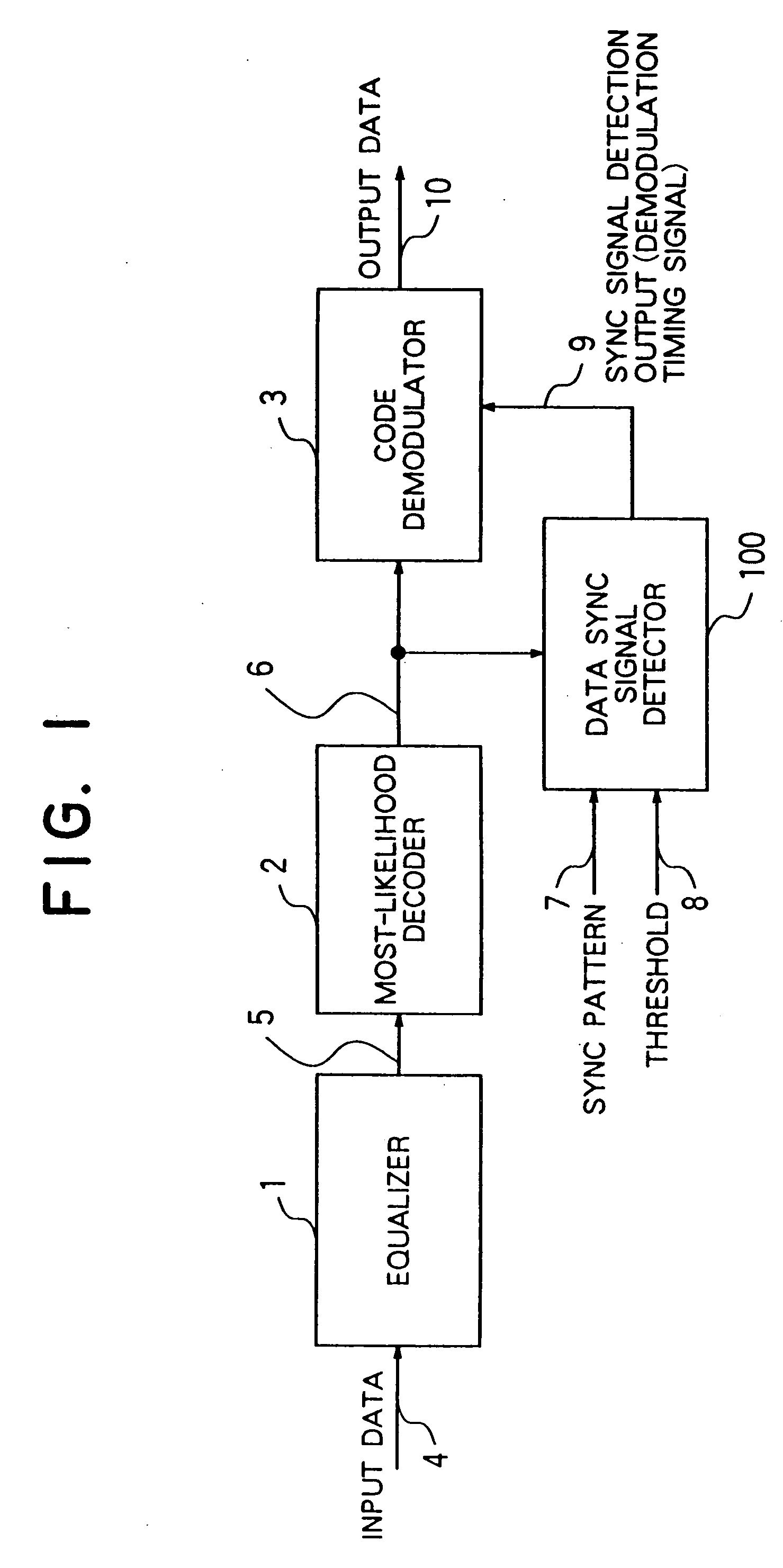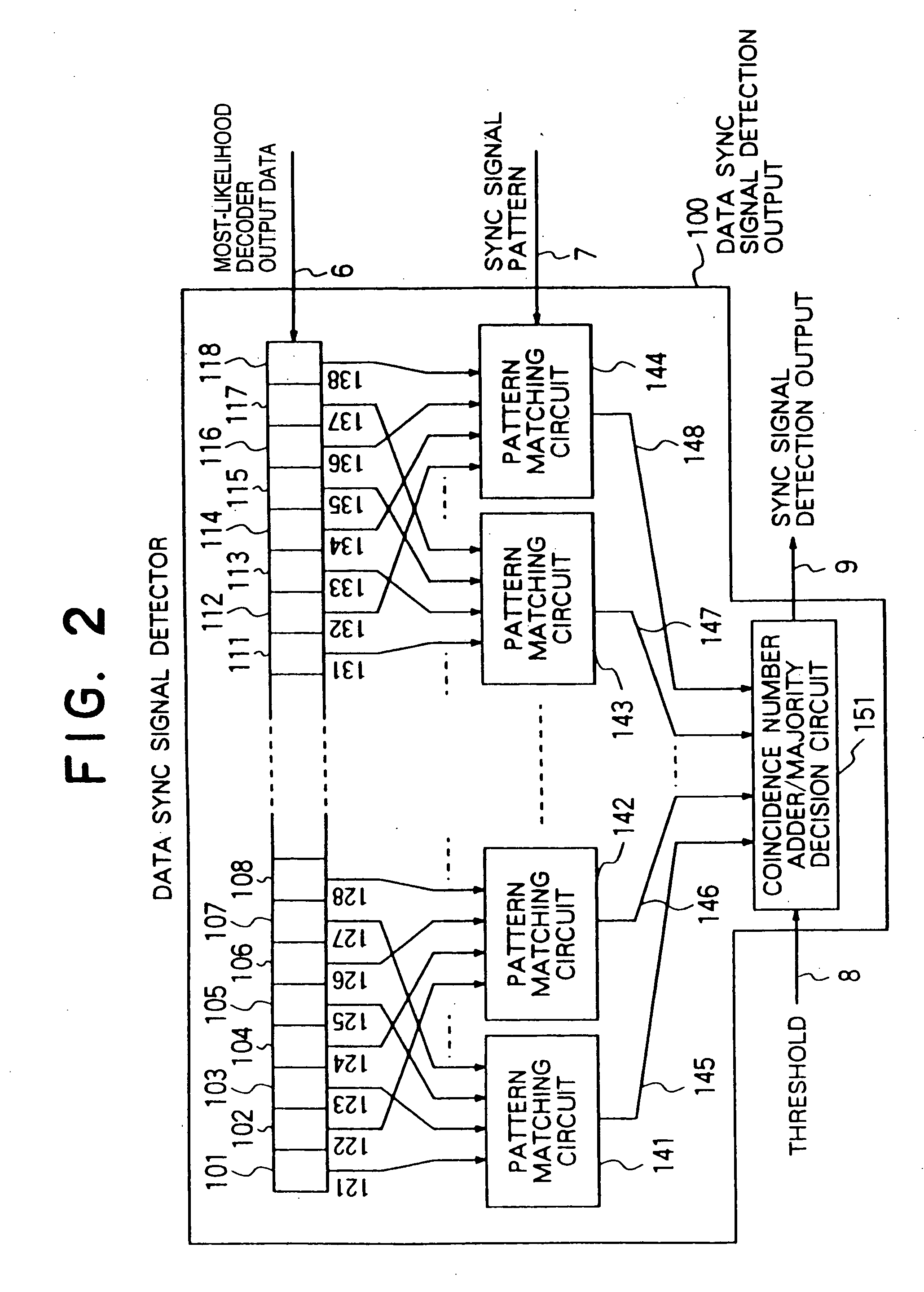Data synchronizing signal detecting device
a data synchronization and signal detection technology, applied in the field of signal processing devices, can solve the problems of reducing the detection error of sync signals, improving the data discrimination performance of a data discriminator, and requiring positive improvement of sync signal detection performan
- Summary
- Abstract
- Description
- Claims
- Application Information
AI Technical Summary
Benefits of technology
Problems solved by technology
Method used
Image
Examples
first embodiment
[0068] The configuration and operation of a data sync signal detector according to the invention will be described more specifically with reference to FIG. 3.
[0069] In the first embodiment, the total number of groups is 2, the threshold value is 1 and each group is configured of five bits, for example.
[0070] The output data 6 of the most-likelihood decoder is applied to the bit cell of the shift register 310 and sequentially shifted and held in the shift register bit cells 309 to 301.
[0071] The shift register bit cell outputs 321 to 330 are separated into an odd-numbered string and an even-numbered string input and applied to pattern matching circuits 341 and 342, respectively. In other words, the shift register bit cell outputs 321, 323, 325, 327, 329 of the odd-numbered string are applied to the pattern matching circuit 341, and the shift register bit cell outputs 322, 324, 326, 328, 330 of the even-numbered string are applied to the pattern matching circuit 342.
[0072] The odd-...
second embodiment
[0105] Now, the invention will be explained with reference to FIG. 4.
[0106] The second embodiment concerns an example in which the number of the groups is 2, the threshold value is 1 and each group is configured of 6 bits.
[0107] The output data 6 of the most-likelihood decoder is input to a shift register bit cell 412 and shifted and held in the bit cells 411 to 401 sequentially.
[0108] The shift register bit cell outputs 421 to 432 are separated into an odd-numbered string and an even-numbered string and input to pattern matching circuits 441 and 442. Specifically, the shift register bit cell outputs 421, 423, 425, 427, 429, 431 of the odd-numbered string are applied to the pattern matching circuit 441, and the shift register bit cell outputs 422, 424, 426, 428, 432 of the even-numbered string are input to the Pattern matching circuit 442.
[0109] The odd-numbered string is matched with “010011” as a predetermined sync pattern, and the result 443 thereof is output. The even-numbere...
third embodiment
[0122] Now, the invention will be explained with reference to FIG. 5.
[0123] This third embodiment concerns a case in which the total number of groups 4, the threshold hold value is 2 and each group is configured of four bits. The most-likelihood decoder output data 6 is applied to a shift register bit cell 516 and sequentially shifted and held in bit cells 515 to 501. Shift register bit cell outputs 521 to 536 are separated into odd-numbered strings and even-numbered strings and applied to pattern matching circuits 541 to 544.
[0124] Specifically, the shift register bit cell outputs 521, 523, 525, 527 of the first-half odd-numbered string are applied to the pattern matching circuit 541, and the shift register bit cell outputs 529, 531, 533, 535 of the last-half odd-numbered string are applied to the pattern matching circuit 543.
[0125] The shift register bit cell outputs 522, 524, 526, 528 of the first-half even-numbered string, on the other hand, are applied to the pattern matching...
PUM
| Property | Measurement | Unit |
|---|---|---|
| storage area | aaaaa | aaaaa |
| recording density | aaaaa | aaaaa |
| transmission | aaaaa | aaaaa |
Abstract
Description
Claims
Application Information
 Login to View More
Login to View More - R&D
- Intellectual Property
- Life Sciences
- Materials
- Tech Scout
- Unparalleled Data Quality
- Higher Quality Content
- 60% Fewer Hallucinations
Browse by: Latest US Patents, China's latest patents, Technical Efficacy Thesaurus, Application Domain, Technology Topic, Popular Technical Reports.
© 2025 PatSnap. All rights reserved.Legal|Privacy policy|Modern Slavery Act Transparency Statement|Sitemap|About US| Contact US: help@patsnap.com



